
Material - Artificial Leather
Artificial leather requires somewhat less maintenance than leather, yet it is nearly as durable, making it a useful
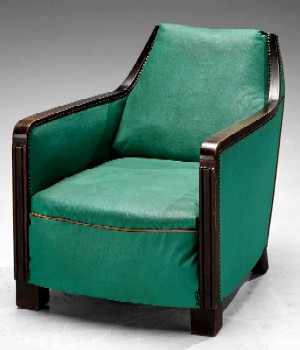
Armchair, Wood and Green Faux Leather, French, 1940s, Morentz
material which gained some popularity among designers in the 1920s.
One of the early artificial leathers was a material called Presstoff which was made of specially layered and treated paper pulp in Germany in the 19th century, but it tended to fall apart under repeated use and exposure to moisture, so it had limited commercial use. It was used by the Germans during World War II because of leather rationing. There was a great deal of experimentation for ways to create 'better' leather or leather substitutes in the late 19th century including using leather scraps to create a composite material and trying to coat cloth with various materials.
In 1904, Russian military officer and engineer Mikhail Pomortsev invented a leather substitute by mixing egg yolk, rosin and paraffin wax and impregnating kersey wool with it. It was expensive to create, remaining so until synthetic latex was created, replacing Pomortsey's mixture. It was called Kirza, which was short for the Russian Iskusstvennaya Kozha (artificial leather). Kirza SK was invented during the 1920s by impregnating multi-layer cotton with a synthetic rubber type substance and vacuum manufacturing the pigskin substitute. Kirza SK was breathable yet waterproof, being first used in 1936-7 and employed as a replacement for leather goods beginning in 1940. It likely saw little or no use in Art Deco or Streamline Moderne products.
Rexine was patented in 1915 by Rexine Ltd of Hyde in the United Kingdom. Rexine was made from cloth surfaced with cellulose nitrate, camphor oil, pigment and alcohol, which was embossed to give it a leather-like appearance. It is still in use today. It was used in the 1920s for a variety of purposes such as bookbinding and teddy bear paws, but it's primary use was in railway car and automobile upholstery. There were also ads for the use of the material in furniture, one of which is included in the images below.
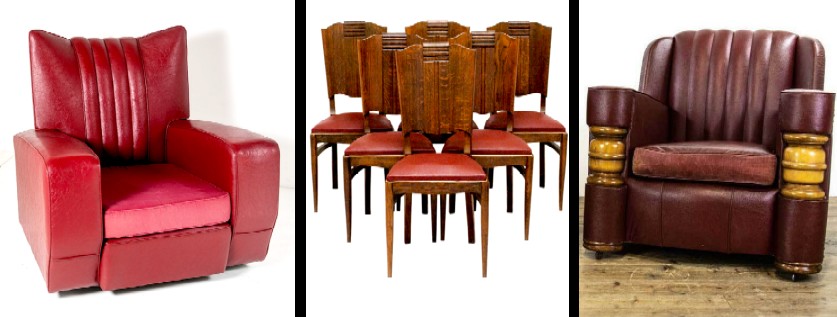 Rexine Upholstery Use, From left - Armchair, Red Rexine Upholstery, 20th Century, Greecore Design, Dining Rooms Chairs, Oak with Burgandy Rexine Seats, Charles Dudouyt attr., 1930s - 40s, 1st Dibs; Club Chair, Brown Rexine Upholstery, Wooden Half Plaster Fronts, Penderyn Antiques
Rexine Upholstery Use, From left - Armchair, Red Rexine Upholstery, 20th Century, Greecore Design, Dining Rooms Chairs, Oak with Burgandy Rexine Seats, Charles Dudouyt attr., 1930s - 40s, 1st Dibs; Club Chair, Brown Rexine Upholstery, Wooden Half Plaster Fronts, Penderyn Antiques
The most successful artificial leather process which in use during the Art Deco era was created by English inventors
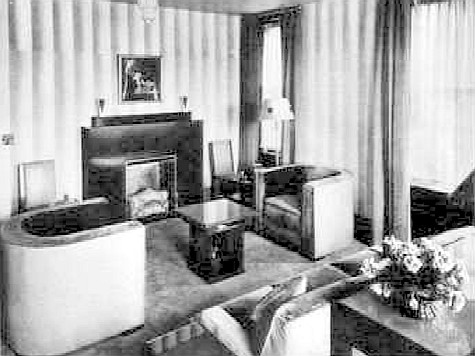
Suite in Dupont Biltmore Hotel, Airbrushed Fabrikoid Walls, Fabrikoid and Velour
Upholstery, Fabrikoid Table Top, 1930, Dupont Fabrikoid Portfolio
Joseph Storey and William Virgo Wilson filed a U.S. patent for "Manufacture of Artificial Leather or Leather Cloth" in 1884. Some of the trade
names for the artificial leather which resulted from this process included Leatherette, Zapon, Tannette, Pegamoid, Moroccoline, Texaderm and Fabrikoid. FabrikoidCo was incorporated in 1902 to make imitation leather, among other chemical products. They acquired the New York leather and Paint company who owned the patent for Fabrikoid and Pegamoid. Under their ownership, Fabrikoid was primarily used for furniture upholstery and curtains for horse drawn buggies. E. I. Dupont bought FabrikoidCo in 1910 and patented their process in 1915.
Fabrikoid is made by coating a cotton with a cellulose nitrate called pyroxylin. It "was manufactured by coating rolls of cotton fabric with a 'dope' or 'jelly' of nitrocellulose dissolved in castor oil, alcohol, benzene, and amyl acetate... [being] produced by a highly mechanized process in three-hundred-yard lengths." (Jeffrey L. Meikle, "Presenting a New material: From Imitation to Innovation with Fabrikoid", The Journal of the Decorative Arts Society 1850 - the Present, No. 19 (1995), p. 8)
The manufacturing process used machines which had previously been developed for the textile and rubber sheeting industries. It began with cloth 60" wide x 300 yards long which was then dyed to provide a uniform color. After dying, the cloth was unrolled over a diagonal table so that loose threads could be removed. Dirt and lint

Tavern Club, Chicago, Gray Fabrikoid Walls, Chairs and Tabletops, 1930, Dupont Fabrikoid
Promotional material
were manually removed by a cleaning machine which also raised the fabrics' nap.
It was then coated by moving it under a spreading knife which forced the dope/jelly into the fabric and dried. This process was repeated several times, the number being based what produced the optimal qualities for the its intended use. The nitrocellulose formulation could also be modified for the same reason. Several layers of this treated material were then pressed together and a polish was added to the top surface. For more expensive iterations, a pattern could be embossed and additional coloring added to better mimic animal hide. The whole process only took a few hours.
The resulting material was much more regular in appearance than real leather making it desirable for use in finished goods. Unlike Rexine, the fabric was embedded in the coating, strengthening the coating and making it resistant to water, polish, oil and grease. "No doubt it was a game changer in the leather industry and was used widely for book binding, upholstery, automotive car tops and interior linings, boxes etc." (Ebenezer Kotel, "Fabrikoid - A Game Changer", Hagley Museum and Library website, gathered 4-21-24)
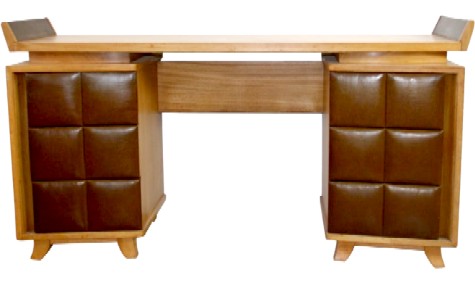
Vanity, Mahogany with Fabrikoid Padded Drawers, Gilbert Rohde for Hermann MIller,
1930s, 1st Dibs
If it could not claim greater durability than prime grain leather, it could still claim superiority in visual appearance. Real animal skins, electrolytically reproduced in copper, contributed 'the exact depth and contour of the grain' to the embossing plate, thereby creating 'perfect reproductions' complete down to 'every pimple and pore'. The salesmen's handbook describing this process, an uncannily astute document, observed that the 'fidelity' of the process 'curiously' gave 'leather substitutes a much more beautiful grain than the average grain of real leather'. To find one real hide suitable for imitation - to find, in other words, that rare exception to flawed nature, a specimen 'in which the grain is ideal' - it was necessary to ransack 'great piles of real hides'. (Meikle, p. 12)
This regular appearance must have made it an appealing choice to some of the decorators who used it as seen in the examples here. Its uniform size and lack of flaws must have made it particularly appealing to furniture manufacturers in the 1930s, when cost was an important factor and mass-produced industrial designers came to the fore. In 1933, Dupont produced "a handsome booklet in strikingly modernistic silver and black explored the uses of Fabrikoid as a wall covering and upholstery material for many of the futuristic interiors of pavilions at the Chicago Century of Progress Exposition." (Meikle, p. 13) The 1933 Chicago World's Fair was the touchstone event in America for the Streamline Moderne designs.
 Fabrikoid Upholstery Use in Rooms, From left - Apartment Loggia, Metal Furniture with Fabrikoid Uphostelry, Raimond Hood Designer; Little Carnegie Theater Lobby, Multi-Colored Fabrikoid Wall Panels, Wolfgang Hoffman Designer; Apartment Houae Social Room, Fabrikoid Upholstered Furniture, Wienold Reiss Designer; Note: All Images are from
1930 Dupont Fabrikoid Promotional Material
Fabrikoid Upholstery Use in Rooms, From left - Apartment Loggia, Metal Furniture with Fabrikoid Uphostelry, Raimond Hood Designer; Little Carnegie Theater Lobby, Multi-Colored Fabrikoid Wall Panels, Wolfgang Hoffman Designer; Apartment Houae Social Room, Fabrikoid Upholstered Furniture, Wienold Reiss Designer; Note: All Images are from
1930 Dupont Fabrikoid Promotional Material
Another product worth mentioning here is Naugahyde. Naugahyde was invented in 1914 at the U.S. Rubber plant in Naugatuck, Connecticut; the artificial leather made from Naugahyde was invented in 1920 by combining leather fibers and rubber compounds to fabric. Its first commercial use was in women's handbags in the early 1920s, although other uses were found for it. By March of 1930, makers of railroad cars, autos, buses, trucks and movie theaters started using it to upholster seats. Like Fabrikoid, Naugahyde was seems to have been brought a little later to the furniture designer industry, beginning to appear in the late 1930s and early 1940s.
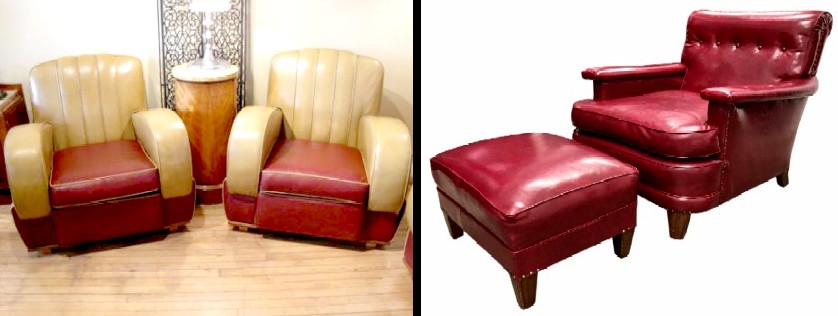 Nagauhyde Upholstery Use, from left - Naugahyde Tan and Burgundy Fabric, Brass Nails, 1930s, Moderism; Club Chair & Ottoman, Red Naugahyde Upholstery with Walnut Legs, 1940s, Chairish
Nagauhyde Upholstery Use, from left - Naugahyde Tan and Burgundy Fabric, Brass Nails, 1930s, Moderism; Club Chair & Ottoman, Red Naugahyde Upholstery with Walnut Legs, 1940s, Chairish
Sources Not Mentioned Above:
"Artificial leather", Wikipedia, gathered 4-21-24
"Kirza", Wikipedia, gathered 4-8-25
"Rexine", Wikipedia, gathered 4-21-24
"A Legacy of Innovation", Naugahyde website, gathered 4-21-24 - https://www.naugahyde.com/about/history.cfm
"Artificial leather", Britannica website, gathered 4-8-25
Albert Varkki, "What is Artificial Leather and Is It Good?", Von Baer website, gathered 4-8-25
For a library of Fabrikoid promotional literature, see the Hagley Organization's Digitial Archives
Original Facebook Group Posting
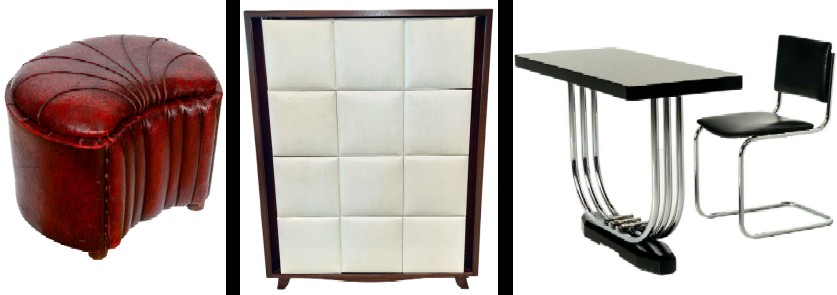 Artificial Leather Upolstery, from left - Boudoir Stool, Probably for Vanity, Scalloped Burgundy Leatherette, English,1930s, 1st Dibs; Four Drawer Chest, 4140, Mahogany with Fabrikoid Padding, Gilbert Rohde for Hermann Miller, 1941, 1st Dibs; Tubular Steel Writing Desk and Chair in P.E.L., Artificial Leather, English, Practical Equipment LTD, 1930s, 1st Dibs
Artificial Leather Upolstery, from left - Boudoir Stool, Probably for Vanity, Scalloped Burgundy Leatherette, English,1930s, 1st Dibs; Four Drawer Chest, 4140, Mahogany with Fabrikoid Padding, Gilbert Rohde for Hermann Miller, 1941, 1st Dibs; Tubular Steel Writing Desk and Chair in P.E.L., Artificial Leather, English, Practical Equipment LTD, 1930s, 1st Dibs